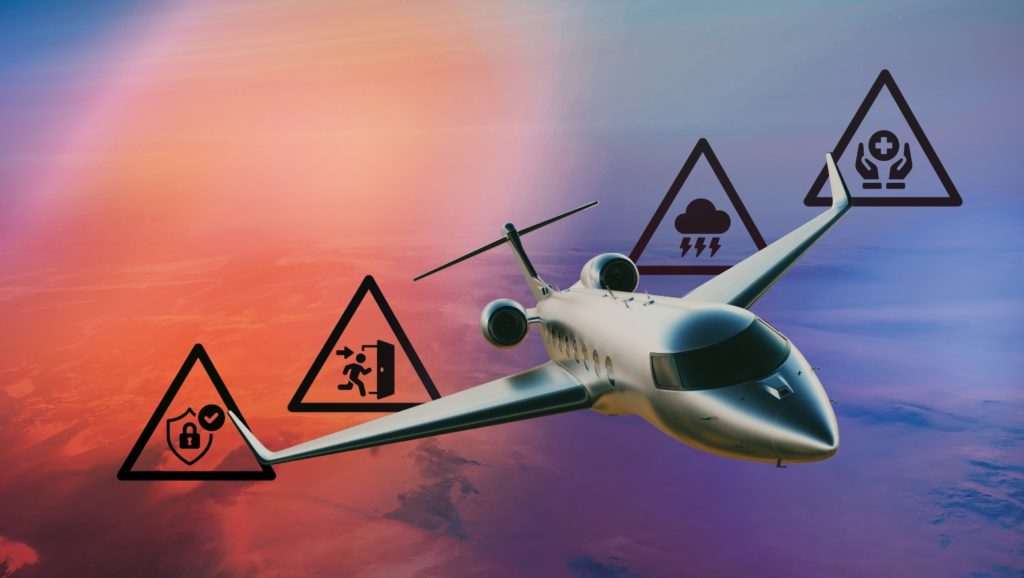Words by Mark Broadbent
According to Matthew Borie, chief intelligence officer, Osprey Flight Solutions, there are four main causes for emergency diversions – weather, safety considerations due to technical or mechanical problems, a medical problem with a passenger or crew, and security issues, such as an unruly passenger or an unlawful act.
Whatever the cause, Borie says a diversion “can have a significant impact, which is why pre-flight risk assessments, pre-planned divert options and access to a trusted security/medical assistance provider are prudent measures.”
Airspace access
All flights typically require a permit to overfly a country. The ICAO Chicago Convention is the primary regulatory document governing airspace access, but the issue of diversions is complicated if in-flight emergencies occur above, or near, territory not recommended for overflights or emergency landings.
How is hostile territory defined? “This all depends on the risk appetite and profile of the operator. What is considered hostile by one entity may not be viewed the same by another,” Borie says.
Flights over Africa present the most risk for private aviation in the event of a diversion, he adds. Borie identifies four key risks of diversions in the continent – infrastructure deficiencies, limited ATC service provision, aviation safety levels, and airport security limitations.
“Several areas of the continent are experiencing increased levels of social unrest and/or armed conflict which make emergency diversions a more complex undertaking,” he says.
The larger geopolitical picture can complicate the issue of managing diversions. “For example, Iran is under a number of US sanctions impacting its aviation sector. This can make it difficult getting spare parts in the event of a mechanical/technical diversion into the country, depending on the type of aircraft being flown.
“Understanding sanctions exposure related to the countries being overflown is a key consideration when conducting an overflight risk assessment,” he adds.
The start of the Russia-Ukraine conflict in February 2022 and the armed clashes in Sudan in April 2023 both highlighted how airspace can close rapidly and with little or no prior advisory.
“These crises have illustrated that operators need dynamic, timely and accurate data-led security intelligence solutions to ensure safe and secure flights near and over conflict zones,” Borie says.
If an emergency arises flying above a hostile territory, an operator must make quick and effective decisions.
“In general, operators are advised to follow the instructions of ATC during overflight, but ultimately the pilot in command is responsible for the conduct of the flight. Once on the ground, local national laws are in effect,” says Borie.
Risk assessments

So how do business aviation companies handle emergency situations? Borie advises: “Operators need to develop a process and/or work with a trusted security provider that can cut through the political and diplomatic influences while minimizing bias to identify the actual risk specific to the flight operation.
“Customized mitigation measures can then be developed and implemented to meet the needs of the specific aviation operator when evaluating divert options.”
According to Borie, risk assessment is at the heart of effective planning for emergency landings. “Pre-flight risk assessment should include pre-planned divert options. An operator should have an inflight emergency plan and an on-ground emergency response plan. Each of these should be actioned.
“Pre-planned divert options should include specific instructions for protocols to be taken at each airport, whether in a hostile country or otherwise. Overflight risk assessments need to be undertaken for all flights and all airspace along a route – not just for areas near or over conflict zones or hostile countries.”
Borie says effective pre-journey risk assessment should be tied to those four key causes of diversions – weather, technical, medical and security. Operators should evaluate MET/WX and SIGMETS as part of the pre-flight plan, ensure the airworthiness of the aircraft, conduct fit-to-fly triage for all crew and passengers, and enact advance passenger information sharing protocols, he says.
Scenario-based training for inflight emergencies should be conducted on a recurring basis to prepare aircrew for an emergency landing, Borie adds. “In addition, involving the pilots in the divert planning process when conducting overflight risk assessments prior to the flight will continuously familiarize the crew with the inflight emergency plan and the emergency response plan,” he says.
There are slightly different considerations for a helicopter emergency landing, Borie says: “Helicopter diversions allow for more options for landing, however the decision-making timeline for a rotary-wing diversion is much shorter, as these flights occur at lower altitudes and have less fuel available. These constraints can increase the complexity of a diversion and the speed at which it occurs.”
Medical emergencies

Business aviation flight crew and operators are faced with many challenges when dealing with medical emergencies – says Richard P. Gomez, vice president of aviation products and management worldwide at MedAire.
Gomez says, “An aircraft is not equipped to handle all types of medical situations, and the limited space and resources on board can make it difficult to respond effectively. The lack of medical expertise is another critical issue. In commercial flights, there may be a chance of a medical professional being onboard, but this is less likely in a chartered flight…This places a considerable burden on the crew, who must make immediate decisions in high-pressure situations without the benefit of extensive medical training.
“The confined space of an aircraft can further complicate matters, as it can limit the ability to move and treat the patient effectively. Language barriers, if present, can also pose a challenge, particularly in understanding the patient’s symptoms and medical history.
“The remote location of an aircraft during flight and the need to coordinate with ground-based medical services can add to the situation’s complexity. The crew must relay accurate information about the patient’s condition to ground-based services. This requires a reliable communication system and a well-coordinated response, which can be challenging to achieve during an emergency.”
Responsibilities
A comprehensive medical kit meeting regulatory requirements – its contents and how to use them effectively should be familiar to all crew members – and a reliable communication system to contact ground-based medical support are essential.
Gomez says MedAire “ensures that aircraft are equipped with medical kits that comply with global regulations set by civil aviation authorities. These kits enable crew members to respond effectively to the most common in-flight medical emergencies.”
But handling medical situations is not just about the kit. Gomez says, “Business aviation companies have significant legal and regulatory responsibilities when handling in-flight medical emergencies. Companies must ensure that their crews are adequately trained, have the necessary medical equipment on board, and have protocols in place for managing medical emergencies.”
MedAire offers training packages that can ensure crew members are certified and proficient in CPR and using an Automated External Defibrillator (AED). Gomez says training for flight crews and ground staff should include first aid procedures that are adapted to the constraints of limited space and resources of a business aircraft.
“However, training should go beyond these essential skills. It should also instil confidence in the crew to effectively mitigate various medical scenarios that may occur. This includes assessing a passenger’s condition under pressure, managing common in-flight medical emergencies, and coordinating effectively with ground-based medical support,” says Gomez.
“The combination of tailored scenarios, appropriate onboard equipment, and robust ground support can significantly enhance the crew’s ability to handle in-flight medical emergencies.”
According to MedAire’s data, ear, nose and throat issues account for 17% of medical emergencies in flight, followed by gastrointestinal (16%), neurological (15%), musculoskeletal (9%), and respiratory and cardiac issues (each 6%). Crews need to be trained to understand symptoms, provide appropriate first aid, and know when and how to seek additional medical assistance, Gomez says.
Protocols and coordination

Gomez adds, “It is important operators establish clear protocols for medical emergencies for assessing the passenger’s condition, providing immediate care, coordinating with ground-based medical support, and deciding whether an emergency landing is necessary.”
During an in-flight medical emergency, the response protocol can vary depending on the nature of a flight, passenger profile, and the number of crew members. However, Gomez outlines a general approach.
He says, “Firstly, all available crew members should respond to the emergency. Their roles can be divided based on the situation and the number of crew members available. For instance, one crew member can focus on assessing the passenger’s condition while another retrieves the necessary medical equipment. If there are multiple crew members, one can be designated to maintain communication with ground-based medical support.”
The crew member in contact with the ground-based medical support should provide all relevant information about the passenger’s condition. “This information will enable the medical support team to provide real-time guidance to the crew, assisting in managing the emergency,” Gomez notes.
He continues, “If medical professionals are on board, the crew may ask for their assistance. However, the crew should continue coordinating with ground-based medical support, because they can provide valuable guidance and help determine whether an emergency landing is necessary.
“Effective communication and coordination between the flight crew, ground-based medical support, and available medical professionals are crucial during an in-flight medical emergency. This collaborative approach can help ensure the best possible care for the passenger.”
Ground link
Gomez says telemedicine services have become a vital component in managing in-flight medical emergencies. MedAire has a service called MedLink providing real-time medical advice to crews.
“Given the limitations on board an aircraft, MedLink’s guidance is crucial in helping the crew use available resources to provide immediate care,” he says.
Gomez explains, “A team of medical professionals can guide the crew through first aid procedures, the use of onboard medical equipment, and even complex medical interventions if a professional is available on board.
“In a severe medical emergency that requires a diversion, MedLink can assist in the decision-making process, helping to identify the most suitable airport based on the availability of necessary medical facilities.
“They can also coordinate emergency medical response to meet the aircraft upon landing, ensuring that the passenger receives the required medical attention as quickly as possible.”
MedLink’s telemedicine service enhances the support available to flight crews and passengers by providing expert medical guidance when needed.
Ultimately, Gomez says, “It is not just about managing the medical event but also about ensuring the best possible outcome for the passenger, from the initial response to the follow-up care.”





